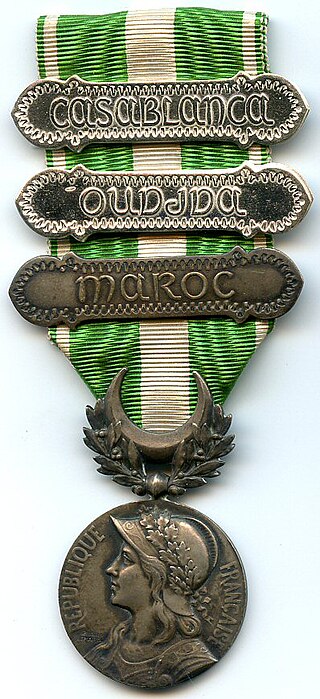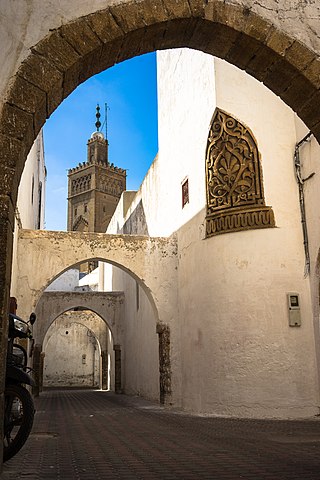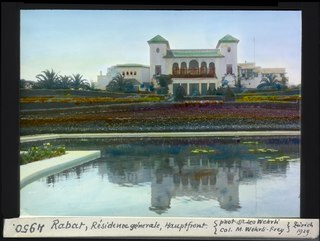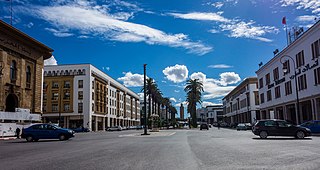

The Equestrian statue of Hubert Lyautey is a public sculpture that commemorates Hubert Lyautey, the first Resident-general of the French protectorate in Morocco, in Casablanca, Morocco.


The Equestrian statue of Hubert Lyautey is a public sculpture that commemorates Hubert Lyautey, the first Resident-general of the French protectorate in Morocco, in Casablanca, Morocco.
The statue was created by French sculptor François Cogné [1] and inaugurated on 5 November 1938 in front of the city's courthouse on Casablanca's main square, now Muhammad V Square. Sultan Mohammed V, Resident-general Charles Noguès, Lyautey's widow Inès de Bourgoing, French minister Guy La Chambre, and other notables attended the ceremony, at which French Academician Louis Gillet gave a florid speech. [2]
A Moroccan stamp of 1946 pictures the statue. [3]
In April 1959, the statue was relocated to the grounds of the nearby French consulate-general in Casablanca, where it remains visible from the square. [4] In 2020, a petition requested the removal of the statue from public view, given its symbolism of Colonial oppression under the French protectorate regime. [5]
33°35′25″N7°37′05″W / 33.59019°N 7.61812°W

Louis Hubert Gonzalve Lyautey was a French Army general and colonial administrator.
Lyautey is the name of:

The French protectorate in Morocco, also known as French Morocco, was the period of French colonial rule in Morocco that lasted from 1912 to 1956. The protectorate was officially established 30 March 1912, when Sultan Abd al-Hafid signed the Treaty of Fez, though the French military occupation of Morocco had begun with the invasion of Oujda and the bombardment of Casablanca in 1907.

Lycée Lyautey is a French institution of secondary education located in Casablanca, Morocco. It is composed of a collège and a lycée, and belongs to the Académie de Bordeaux, an educational administrative district in France. The school was named after Marshal Louis Hubert Gonzalve Lyautey, who was the first French resident general in Morocco from 1912 to 1925, at the beginning of the French protectorate in Morocco.

The history of the city of Casablanca in Morocco has been one of many political and cultural changes. At different times it has been governed by Berber, Roman, Arab, Portuguese, Spanish, French, British, and Moroccan regimes. It has had an important position in the region as a port city, making it valuable to a series of conquerors during its early history.

Henri Prost was a French architect and urban planner born in Saint-Denis. He was noted in particularly for his work in Morocco and Turkey, where he created a number of comprehensive city plans for Casablanca, Fes, Marrakesh, Meknes, Rabat, and Istanbul, including transportation infrastructure and avenues with buildings, plazas, squares, promenades and parks.

The Morocco commemorative medal (1909) was a French military campaign medal. It was established by the law of 22 July 1909 for award to soldiers participating in the Second Franco-Moroccan War under the command of general Hubert Lyautey.

The Hubous, or colloquially Habous, is one of the older neighborhoods of Casablanca, Morocco. Its development dates back to 1916, in the early stages of the French protectorate. The neighborhood is a cultural and religious center for Casablanca and for Morocco, as it hosts the Moroccan Ministry of Islamic Affairs as well as bookstores of important Moroccan and Arabic publishing houses. The many traditional and historic buildings also make the Hubous a popular tourist destination.

Paul-Jean-Louis Azan was a French general and author. He is remembered for his missions to the United States during World War I and his French historical and military writings which examined and celebrated French Colonial rule in North Africa.

François Cogné was a French sculptor. His work was part of the sculpture event in the art competition at the 1924 Summer Olympics.

Inès-Marie de Bourgoing, also Inès Fortoul, Inès Lyautey, was a pioneering French nurse who served as president of the French Red Cross and established Red Cross nursing in Morocco. In recognition of her extensive social work, she became the first woman to be honoured with the rank of Grand Officer of the Legion of Honour. She was also decorated as a Grand Officer of the Order of Ouissam Alaouite in recognition of her work in Morocco.

Bousbir was a walled-off brothel quarter in Casablanca, Morocco, established by Resident General Lyautey during the French protectorate.

The Bombardment of Casablanca was a French naval attack taking place from August 5 to 7 in 1907 that destroyed the Moroccan city of Casablanca. France used mainly artillery fire from armored cruisers to bomb the city and targets in the surrounding area, which caused an estimated 1,500 to 7,000 Moroccan deaths. The bombardment of Casablanca opened a western front to the French conquest of Morocco after Hubert Lyautey's occupation of Oujda in the east earlier that year.

United Nations Square is a public square in the center of Casablanca, Morocco. It has been central in the history of Casablanca.

Mohammed V Square is a public square of historical and symbolic significance located in central Casablanca, Morocco. It was established in 1916 at the beginning of the French protectorate in Morocco under Resident-general Hubert Lyautey, on a design by architects Henri Prost and Joseph Marrast.

The architecture of Casablanca is diverse and historically significant. Casablanca, Morocco's economic capital, has a rich urban history and is home to many notable buildings in a variety of styles. Throughout the 20th century, architecture and urban development in Casablanca evolved in a way that was simultaneously specific to the city's contexts, and consonant with international ideas.

The French Protectorate Residence also known as Residence-general or Residence of Lyautey, is a historic building in Rabat, Morocco. It was the seat of the Resident-general in the French protectorate in Morocco from its completion in 1924 to the end of the protectorate in 1956.

The State Bank of Morocco was a quasi-central bank established in 1907 following the Algeciras Conference, to stabilize the Moroccan currency and serve as a vehicle for European and especially French influence in the Sultanate of Morocco. Following the independence of Morocco, it was replaced in 1959 by the newly created Banque du Maroc, known since 1987 as Bank Al-Maghrib.

Avenue Mohammed V, sometimes referred to by its old name Avenue Dar al-Makhzen, is a major thoroughfare in downtown Rabat, Morocco. Its main section was created under the French Protectorate in Morocco and mostly developed between 1915 and 1932, when it was also known as Cours Lyautey. At the southern end of that section is the As-Sunna Mosque, whose history dates back to the 18th century like that of the nearby royal palace or Dar el-Makhzen.